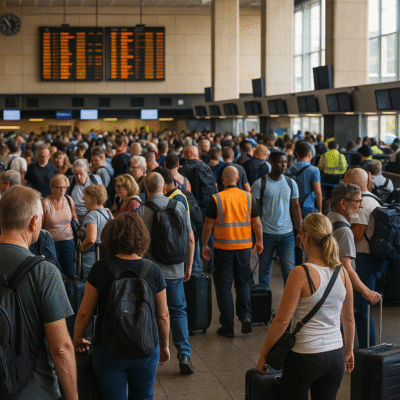June 2025 | Brussels, Paris, Lisbon –
As Europe prepares for a record-breaking summer travel season, a major breakthrough is reshaping how UK citizens move through European borders. In a long-anticipated update, 49 airports, ports, and terminals across the European Union—including major hubs like Paris Charles de Gaulle, Lisbon, Amsterdam Schiphol, Sofia, and Ibiza—have officially reopened eGate access for UK passport holders.
This fast-track privilege, previously restricted after Brexit, now brings much-needed relief for British holidaymakers. It coincides with a deeper transformation across Europe’s borders: the upcoming launch of the EU Entry/Exit System (EES) in October 2025. This digital border system will eventually replace passport stamps with biometric data like fingerprints and facial recognition scans.
Together, the eGate access and the EES launch mark a new chapter in post-Brexit travel—one promising faster processing, higher security, and better traveler satisfaction.
From Chaos to Confidence: Why eGate Access Matters
Since the UK’s departure from the EU, British travelers have faced longer waits, confusing entry rules, and frustrating delays at Schengen borders. Many were forced into manual passport lanes, where overwhelmed staff and outdated systems led to missed flights and travel anxiety.
Now, with fast-track eGates reopened at dozens of major terminals, UK travelers can bypass queues and experience streamlined entry—especially at peak-time hotspots like Paris CDG, Rome Fiumicino, Brussels, Faro, and Mallorca.
Here’s a sample of where eGate access is now available to British tourists:
- France: Paris Charles de Gaulle, Orly, Bordeaux, Marseille, Lyon, Nice
- Italy: Rome, Milan, Venice, Florence, Pisa, Palermo, Cagliari, Naples, Treviso
- Spain: Madrid, Barcelona, Ibiza, Tenerife, Lanzarote, Mallorca, Alicante
- Portugal: Lisbon, Faro
- Belgium: Brussels
- Bulgaria: Sofia
- Netherlands: Amsterdam (exit only)
- Eurotunnel: Folkestone, Calais
- Eurostar: London St Pancras, Paris Gare du Nord
This list includes busy leisure destinations and essential transit points—just in time for a summer where UK-to-EU travel bookings have already surged by 17%.
Entry/Exit System (EES): What UK Travelers Must Know
While eGates are a welcome development for UK passport holders, an even bigger change is just months away. Beginning October 2025, the EU Entry/Exit System (EES) will go live across all 27 Schengen member states.
Here’s what EES means:
- Replaces manual passport stamps with biometric registration
- Logs each traveler’s name, document info, facial image, fingerprints, and exact time/location of entry/exit
- Applies to all non-EU nationals (including Brits, Americans, Canadians, and Australians)
- Automatically enforces the 90-days-in-180-day rule
- Flags overstays and may trigger fines, bans, or delayed reentry
For UK travelers, this means no more physical stamps. Instead, your biometric data and travel records will be stored securely in the EES database. Once enrolled, travelers can use automated kiosks and eGates—making the process more efficient over time.
Why Now? Political and Economic Winds Are Shifting
The reopening of eGate access for UK citizens follows renewed diplomatic momentum between London and Brussels. Under Prime Minister Keir Starmer, the UK has revived talks around practical travel solutions with EU leaders, focusing on smoother mobility and tourism recovery.
EU tourism ministers have also acknowledged the economic value of British tourism. With UK visitors consistently ranking among Europe’s top spenders, the move to fast-track their entry reflects a shared goal: boosting post-pandemic recovery through smarter, tech-driven travel infrastructure.
A Win for Europe’s Tourism Sector
Airlines, hotels, tour operators, and airport authorities have long pushed for simplified border procedures for UK travelers. The eGate expansion arrives just as the EU prepares for its busiest summer since 2019, with travel demand outpacing pre-pandemic levels.
With faster entry now available, airports are expected to see:
- Reduced wait times and fewer missed flights
- Increased last-minute bookings from UK-based travelers
- Higher satisfaction scores and repeat tourism
- Operational relief for border control staff and immigration desks
Meanwhile, tour agencies across the UK are already marketing the “return of frictionless travel” to encourage summer bookings.
The Fine Print: What British Travelers Should Still Be Aware Of
Despite the eGate privileges, UK tourists must remain cautious:
- Passport stamping still applies at non-eGate entry points until EES goes live
- Overstaying the 90/180-day rule can lead to automatic penalties once EES is operational
- Some airports may require biometric enrollment before repeat eGate usage
- ETIAS (European Travel Information and Authorization System), a new pre-arrival visa waiver, will launch in 2026 and apply to all UK travelers
Pro Tip: If you’re traveling after October 2025, expect initial delays at major hubs like Paris and Rome as staff and travelers adjust to the new Entry/Exit procedures.
What Comes Next?
- October 2025: Full rollout of the EU Entry/Exit System (EES) across Schengen countries
- Late 2026: Introduction of ETIAS—mandatory for UK travelers
- 2026–2027: Expansion of biometric gates and kiosks at smaller regional airports
- Ongoing: Evaluation of eGate access for other nationalities and travel corridors
Final Thoughts: The Fast Lane to Europe Is Back—With a Digital Twist
With the reopening of eGates across 49 EU airports and the upcoming rollout of the Entry/Exit System, Europe is ushering in a new era of smart travel. For British holidaymakers, this marks the most significant post-Brexit improvement to travel experience yet.
As biometric technology replaces outdated passport stamping, travelers can look forward to shorter lines, faster entry, and greater confidence in planning European getaways.
But preparation is key. Know your rights, understand the new systems, and plan for early compliance with digital borders. Europe is still open—but the way in is smarter, faster, and more secure than ever.
Ready for takeoff? The gate is open—and the future of European travel is waiting.
For more travel news like this, keep reading Global Travel Wire





















